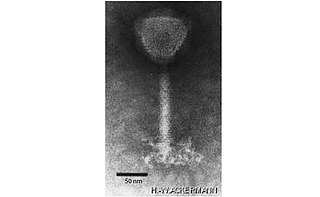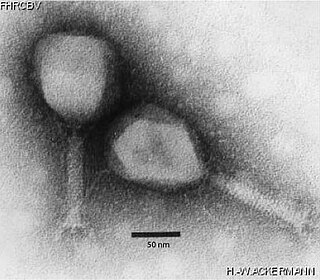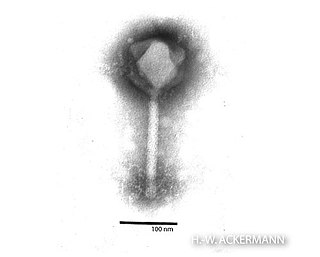Uetakevirus is a genus of viruses in the order Caudovirales, in the family Podoviridae. Bacteria serve as natural hosts. There are three species in this genus. These phages are temperate and infect Salmonella and Escherichia coli.

Okubovirus is a genus of viruses in the order Caudovirales, in the family Herelleviridae, in the subfamily Spounavirinae. Bacteria serve as natural hosts. There are two species in this genus.
Punavirus is a genus of viruses in the order Caudovirales, in the family Myoviridae. Bacteria serve as natural hosts. There are four species in this genus.

Schizotequatrovirus is a genus of viruses in the order Caudovirales, in the family Myoviridae, in the subfamily Tevenvirinae. Bacteria serve as natural hosts. There are three species in this genus.

Tevenvirinae is a subfamily of viruses in the order Caudovirales, in the family Myoviridae. Bacteria and archaea serve as natural hosts. There are 135 species in this subfamily, most included in 12 genera.
Bixzunavirus is a genus of viruses in the order Caudovirales, in the family Myoviridae. Bacteria serve as natural hosts, with transmission achieved through passive diffusion. There are eight species in this genus.
Muvirus is a genus of viruses in the order Caudovirales, in the family Myoviridae. Bacteria serve as natural hosts, with transmission achieved through passive diffusion. There are two species in this genus.
Myohalovirus is a genus of viruses in the order Caudovirales, in the family Myoviridae. Bacteria and archaea serve as natural hosts. There are three species in this genus.

Phikzvirus is a genus of viruses in the order Caudovirales, in the family Myoviridae. Bacteria serve as natural hosts. There are three species in this genus.
Salasvirus is a genus of viruses in the order Caudovirales, in the family Salasmaviridae, in the subfamily Picovirinae. Bacteria serve as natural hosts. There are four species in this genus.
Ravinvirus is a genus of viruses in the order Caudovirales, in the family Siphoviridae. Bacteria serve as natural hosts, with transmission achieved through passive diffusion. There is only one species in this genus: Escherichia virus N15.
Lomovskayavirus is a genus of viruses in the order Caudovirales, in the family Siphoviridae. Bacteria serve as natural hosts. There are two species in this genus.
Psimunavirus is a genus of viruses in the family Siphoviridae. Bacteria and archaea serve as the natural host, with transmission achieved through passive diffusion. There is only one species in this genus: Psimunavirus psiM2.
Spbetavirus is a genus of viruses in the order Caudovirales, in the family Siphoviridae. Bacteria serve as natural hosts. There is only one species in this genus: Bacillus virus SPbeta.

Caulimovirus is a genus of viruses, in the family Caulimoviridae order Ortervirales. Plants serve as natural hosts. There are 12 species in this genus. Diseases associated with this genus include: vein-clearing or banding mosaic.
Chlamydiamicrovirus is a genus of viruses, in the family Microviridae, in the subfamily Gokushovirinae. Various species of chlamidia serve as natural hosts. There are four species in this genus.
Bullavirinae is a subfamily of viruses in the family Microviridae. Enterobacteria serve as natural hosts. There are 14 species in this subfamily, organized into three genera.
Percavirus is a genus of viruses in the order Herpesvirales, in the family Herpesviridae, in the subfamily Gammaherpesvirinae. Mammals serve as natural hosts. There are six species in this genus. Diseases associated with this genus include: conjunctivitis, immunosuppression in foals, pneumonia, respiratory disease.
Spiromicrovirus is a genus of viruses, in the family Microviridae, in the subfamily Gokushovirinae. Spiroplasma bacteria serve as natural hosts. There is only one species in this genus: Spiroplasma virus SpV4.
Turriviridae is a family of viruses; it contains only one genus, Alphaturrivirus. The archaea Sulfolobus solfataricus serve as natural hosts. There are two species in the genus Alphaturrivirus.




